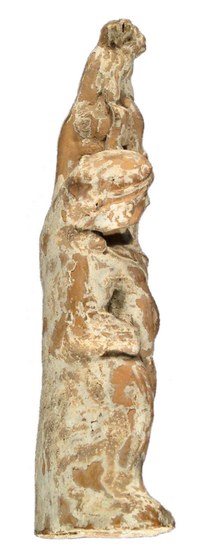Boy with monkey
|
Boy with monkey, Inv. T I-32 Front side from the mould. Back side simply smoothed; rectangular kilning hole, h. 2.5 cm x w. 1.5 cm. Light brown (10YR 7/4-6/4) clay. Abundant white engobe, no traces of paint. Provenance: Unknown. State of preservation: Intact apart from small cracks at the base of the pillar. Dimensions: H: 13,8 cm; W: 7,5 cm; D: 3,3 cm. References: E. Neuffer, Griechische Terrakotten. Heimat im Bild 17, 1930, 68 fig. 6; M. Recke (ed.), Antike Kunst aus der Sammlung der Justus-Liebig-Universität (Gießen 2010) 23. 27 fig. 48. |
Description: On a low rectangular plinth stands a boy with wide-spread sturdy legs, the right one slightly protruding, against a pillar on which a small monkey is sitting. The boy stretches his left arm upwards towards the little monkey, the right one hangs down slightly bent. Apart from a short coat (chlamys) and a cap, the little boy is naked. The chlamys lies like a ribbon on his right shoulder, runs diagonally across his upper body and is wrapped around his left arm. One corner falls down in narrow longitudinal folds. A round belly bulges between the edge of the ribs and the genitals.
The boy has raised his head, tilted it to the right and turned it to the left. A flat round cap, which has a recess above the circumferential rim, is pushed into the forehead. Short wavy strands fall over the temples and frame the cheeks. The chin protrudes sharply from the chubby face. Small hollows sit next to the corners of the mouth. Narrow eyes lie close to the nose.
The smooth pillar, which tapers upwards, is crowned by a capital consisting of a narrow and a wider sculptural bulge. The likewise smooth side parts protrude a little at the front so that they form a kind of frame around the front. At the top, leaning a little to the right, a monkey squats with crossed hind legs, leaning on the base with both arms.
Commentary: The headgear is a kausia[1], a Macedonian cap that became widespread in Greece after Alexander the Great's Indian campaign from about 325 BC. Around the same time, children are no longer depicted as diminutive adults, but childlike with round cheeks, chubby little bellies and stocky thighs. T I-32 shows a complicated stance motif with two interlocked axes. One leads diagonally upwards from the right foot over the left arm to the pillar capital. The other axis connects the left foot, which is slightly set back, with the head turned to the left via the body turned to the right. The latter projects beyond the contour line and thus interrupts the pyramidal structure of the group. Although this is predominantly a frontal view, the folded leg position of the boy, his recessed right shoulder and the elbow pointing backwards give it a certain depth. The right side of the pillar, which can be seen from the front, also supports the spatial effect. A group in Hamburg[2] consisting of a childlike Eroten with a cockerel on a pillar is comparable in structure and style. Here, too, the outwardly stretched cock's tail and a wing of Eros interrupt the otherwise converging contour lines on the side to the viewer's left. Among larger marble works, the statue of a boy from Lilaia can be used for comparison. It differs from T I-32, however, in its more closed contours and the standing motif with crossed legs[3]. Thus, the terracotta group from Giessen could be somewhat younger. Its light brown clay colour points to Boeotia.
Determination: 1st half of the 3rd century BC, Boeotia?
 |
 |
 |
|---|
[1] D. Burr Thompson, Troy. The Terracotta Figurines of the Hellenistc Period (Princeton 1963) 53-55. 86 nos. 52-57 pl. 61; U. Liepmann, Griechische Terrakotten, Bronzen, Skulpturen. Kestner-Museum (Hannover 1975) 91 fig. T 97; E. Paul, Antike Welt in Ton (Leipzig 1959) 84 no. 194 pl. 52; für Zypern s. e.g. H.-G. Buchholz – W. Wamser-Krasznai, Tempelknaben in Tamassos, RDAC 2007, 229-256 pls. 255 a. c.-f. h-j.
[2] L. Frey-Asche, Tonfiguren aus dem Altertum (Hamburg 1997) 57 f. fig. 33; Winter 2, 1903, 279, 1. 3. 10; M. M. Kobylina, Terrakottastatuetten Pantikapaions und Phanagoreias. russ. (Moskau 1961) 4 pl. 16; L. Burn – R. Higgins, Greek Terracottas 3 (London 2001) 122 no. 2287 pl. 51.
[3] H. Rühfel, Das Kind in der griechischen Kunst (Mainz 1984) 225 f. pl. 95.

